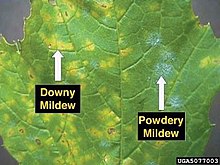Powdery mildew
| Powdery mildew | |
|---|---|

Example of powdery mildew (right) along with Downy mildew on a grape leaf
|
|
| Causal agents | Species of fungi in the orders Erysiphales |
| Hosts | plants |
Powdery mildew is a fungal disease that affects a wide range of plants. Powdery mildew diseases are caused by many different species of fungi in the order Erysiphales, with Podosphaera xanthii (a.k.a. Sphaerotheca fuliginea) being the most commonly reported cause.Erysiphe cichoracearum was formerly reported to be the primary causal organism throughout most of the world. Powdery mildew is one of the easier plant diseases to identify, as its symptoms are quite distinctive. Infected plants display white powdery spots on the leaves and stems. The lower leaves are the most affected, but the mildew can appear on any above-ground part of the plant. As the disease progresses, the spots get larger and denser as large numbers of asexual spores are formed, and the mildew may spread up and down the length of the plant.
Powdery mildew grows well in environments with high humidity and moderate temperatures. In an agricultural setting, the pathogen can be controlled using chemical methods, genetic resistance, and careful farming methods. It is important to be aware of powdery mildew and its management as the resulting disease can significantly reduce crop yields. Greenhouses provide an ideal moist, temperate environment for the spread of the disease.
Powdery mildew fungi reproduce both sexually and asexually. Sexual reproduction is via chasmothecia (formerly cleistothecium), a type of ascocarp. Within each ascocarp are several asci. Over time, ascospores mature and are released to initiate new infections. Conditions necessary for spore maturation differ among species.
Wooly aphids (Eriosomatinae) and other sucking insects are often vectors of transmission for powdery mildew, and other infectious diseases. Typically wooly aphids in sub temperate climates precede and are an indicator of various infections, including Powdery mildew. Aphids penetrate plant surfaces where they often reside and provide a host of potential inoculants through physical, digestive or fecal secretions. Aphids are often an indicator of other potential plant problems.
...
Wikipedia
